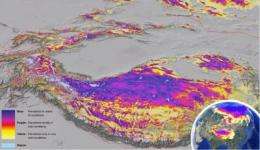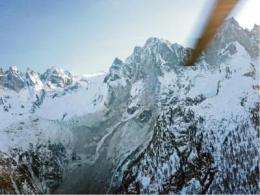Global permafrost zones in high-resolution images on Google Earth

Thawing permafrost will have far-reaching ramifications for populated areas, infrastructure and ecosystems. A geographer from the University of Zurich reveals where it is important to confront the issue based on new permafrost maps -- the most precise global maps around. They depict the global distribution of permafrost in high-resolution images and are available on Google Earth.
Unstable cable-car and electricity pylons and rock fall – Alpine countries like Switzerland have already had first-hand experience of thawing permafrost as a result of climate change. If temperatures continue to rise, the problem will intensify in many places. Permafrost, namely rock or soil with a negative temperature for at least two years, occurs in the subsurface and therefore cannot be mapped directly. The existing maps are thus fraught with major uncertainties that have barely been studied or formulated. Furthermore, due to the different modeling methods used the maps are difficult to compare.
The most precise global permafrost maps
Now, however, glaciologist Stephan Gruber from the University of Zurich has modeled the global permafrost zones for the first time in high resolution and using a consistent method. In his study recently published in The Cryosphere, the scientist estimates the global permafrost regions at 22 million square kilometers – a sixth of the world's exposed land surface. With a grid resolution of one square kilometer, Gruber's maps are the most precise permafrost maps in the world..

Approximation of permafrost patchwork
A large proportion of the permafrost zones lie outside the areas that exhibit continuous permafrost in the subsurface. At relatively small distance, permafrost can here occur right next to non-permafrost ground. In other words, the spatial distribution of permafrost resembles a patchwork quilt, which makes it extremely difficult to identify zones with permafrost in such areas. This is where Gruber's innovative permafrost maps come in: They are based on high-resolution air temperature and elevation data. Moreover, they reveal an index that indicates the probability of permafrost. The permafrost areas are depicted in grades – from dark blue for near-continuous permafrost to yellow for areas with little permafrost. In contrast to previous permafrost maps, which show clearly defined zones, Gruber's maps also illustrate the uncertainty of the state of research.
The scientist explains his motivation with the urgency of the matter: "As a result of climate change, areas with permafrost have great potential for unpleasant surprises. That is why it is all the more important for politics and the public to be aware of the problem of thawing permafrost. My maps visualize the otherwise barely visible phenomenon of permafrost."
More information:
Global Permafrost Zonation Index Map: www.geo.uzh.ch/microsite/cryod … ZonationIndexMap.kmz
Publication: www.the-cryosphere.net/6/221/
Stephan Gruber. Derivation and analysis of a high-resolution estimate of global permafrost zonation. The Cryosphere 6, 221-233, 2012, doi: 10.5194/tc-6-221-2012
Provided by University of Zurich


















